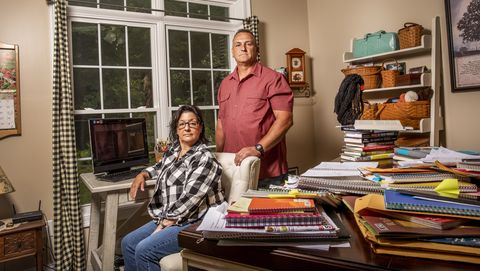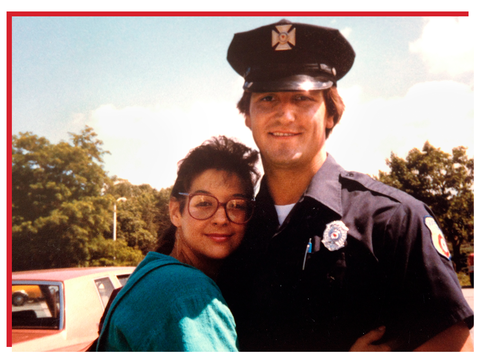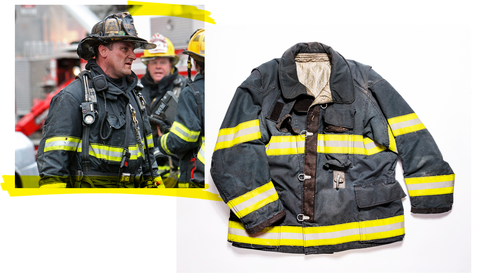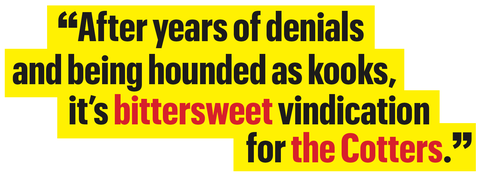IT WAS WINTER 2015, and Diane Cotter was in the cellar, tearing through boxes. Upstairs, the inside of the tidy southern New Hampshire home she shares with her husband, Paul, is something of a shrine to firefighting—Paul’s commendations on the armoire, photos, boxes of swag and mementos accumulated from a lifetime on the rescue truck in Worcester, Massachusetts. But Paul’s firefighting gear was packed away in the cellar. It was too hard to look at.
Even at 55, Paul was in top physical shape. Thick and barrel shaped, with close-cropped hair, he is a bear of a man. At his peak, he could deadlift 495 pounds, and he liked to boast, in his heavy Worcester accent, that he was one of only two guys in the firehouse who could climb up the three-story fire pole. His diagnosis—prostate cancer, aggressive—on November 20, 2014, was shattering. Overnight, his life became medicalized. The tumor scored a seven out of ten on the Gleason scale, whatever the hell that was. Bad, but could be worse, the oncologist explained. They could excise the tumor, the hotshot surgeon in Boston said to them. Nobody mentioned the eventual side effects—the incontinence, the impotence, the weakness—but none of that matters when you start measuring your life expectancy in five-year chunks. The rhythms of Paul’s life changed from shifts and calls to regular blood draws, post-op meetings, and fears of relapse.
In the cellar, Diane muscled Paul’s fire-resistant trousers out of the box. She was no firefighter, but Diane knew her way around what the squad called “turnout gear.” For almost 40 years, since he had first flashed a smile at her from his baby-blue Cadillac during her junior year of high school, Diane had been by Paul’s side. Although she raised two kids and worked half a dozen jobs over the years, her home was always open to hundreds of firefighters from Local 1009 and their families whenever somebody made captain or didn’t come home from a shift. She was terrified for Paul’s safety, but she knew he lived for the job. Plus, she couldn’t deny she loved the smell of smoke that clung to him when he walked in the door.

The diagnosis had forced Paul into a retirement he wasn’t ready for and sunk him into depression, but it had thrust Diane toward a new obsession: finding the culprit, the reason why Paul was the only man in his large family to be diagnosed with a cancer known to run in families. Why was it that cancer had torn a hole in nearly every firefighting family they knew, all across America?
Late one night on the Internet, she discovered that the lining that was part of all firefighting gear might be a cause. It wasn’t until two years later that she found out more: that it contained man-made chemicals called perfluoroalkyl and polyfluoroalkyl substances, or PFASs. This is a ubiquitous class of chemicals, the stuff that makes Teflon slick and Scotchgard stain-resistant—but, she would soon learn, it also includes widespread environmental toxicants and substances that interfere with the body’s hormonal functions. It’s linked to various adverse health effects, including cancer. She stopped the Googling and picked up Paul’s gear. She shined his old field flashlight at the high-tech lining, and light poured through several holes near the groin. The chemical-laden lining was degrading. She wondered if that was the trouble. If so, Paul had been vulnerable, day after day, week after week, for a decade.
It was the beginning of a six-year odyssey, a quest to protect firefighters from the gear that was supposed to save them, an undertaking that would, to the Cotters’ devastating surprise, alienate friends and pit them against their union and some of the most powerful corporations on earth. Given that PFASs are also in all kinds of common household products, was it possible that firefighters were the canaries in the coal mine?
Diane felt ill.
PAUL READS NAMES FROM a list in the Cotters’ makeshift war room—a former crafting room with a listless Internet connection, no cell service, and a lot of yarn—while Diane practices a speech for a conference on toxic chemicals and activism. It’s a late-May morning earlier this year, and Paul has just gotten over the mild symptoms of his second Covid shot. His list, stored on an aging yellow notepad, is up to 32 neatly written names. Each is a firefighter who has reached out to him, and beside each entry is a letter—P for prostate, T for testicular, B for brain, and so on. “When I came home after my surgery, I started getting calls,” he says. “I was getting one a month. I still get calls.”
There are many ways to die in the fire service, and firefighters train to avoid the most gruesome. But today, most active-duty firefighters do not die from falling beams or back drafts—they die from cancer. Cancer is now the number-one killer in the fire service. Firefighters have a 9 percent higher risk of cancer, and a 14 percent higher risk of dying from cancer, than the rest of the population. “Every firehouse is a cancer cluster,” Diane likes to say, and she’s right. A firefighter is twice as likely as a civilian to get testicular cancer, 53 percent more likely to contract non-Hodgkin’s lymphoma, and 28 percent more likely to develop prostate cancer, like Paul.
Paul doesn’t like to talk about what cancer took from him, but he talks to all the firefighters who call, for as long as they want, about treatments, disability, the things nobody tells you—the anxiety, the depression that comes from having a job you loved, a purpose, torn from you too soon. Paul says he’s one of the lucky ones. Doctors say he’s cancer-free now, though treatment left its scars, both physical and mental.
Most firefighters assume their cancers come solely from carcinogens in the smoke they inhale. But for the better part of a decade, Paul and Diane have been out to prove that not all cancer in the fire service is directly related to the fires they fight. Some of firefighting’s most common cancers, like testicular and prostate, may not be tied to breathing in smoke at all and instead could be more closely related to four letters that have come to dominate the Cotters’ lives: PFAS. “These people don’t know they’re being poisoned,” Paul says.

To understand the problem, you need to go all the way back to April 6, 1938, to a New Jersey laboratory owned by the chemical giant DuPont. That fateful day, an experiment went awry. Instead of making a refrigerant, a young chemist accidentally created a brand-new substance, one of the slipperiest materials on earth. The molecules that defined this new class of chemicals formed a profoundly strong carbon-fluorine bond. Substances coated in it not only repelled water and resisted stains; they could handle extreme temperatures and insulate electrical wires. DuPont patented Teflon, and by 1956 the first nonstick pans were on the market. Soon after, companies began developing new, related PFASs that would appear in products like Scotchgard and Gore-Tex. Today, PFAS compounds—there are thousands of them—are popularly known as forever chemicals because of their strong bond and refusal to degrade. A better name might be everywhere chemicals: They’ve become a mainstay in engines and electronics, carpeting and couches, stain-resistant pants and wrinkle-free shirts, shampoo and floss. And, of course, an integral part of firefighting gear.
YOU WANNA SEE ‘THE RABBIT HOLE’?” Diane asks, opening up her AOL account on the Cotters’ desktop PC. She calls herself a fat little housewife, which is untrue except for her diminutive stature, and she speaks with the thick accent of her native Worcester (or “Woosta,” as she puts it). If Paul is the counselor to firefighters everywhere, Diane is the advocate. And the rabbit hole is the AOL folder where she files all the emails she’s sent in her search for the truth about PFASs and firefighters. On this May day, it’s at 15,000-plus. She is a prolific emailer, and her missives are something to behold: Formatting is rough and capitalization a bit random, the sender line has no name (emails just arrive from “d”), and the recipients include union bosses, heads of environmental groups, and senators. It can all seem like the ravings of a crank, except Diane has meaningful correspondence with these people. “It’s easier for people to give me what I want than to have to keep putting up with me,” she laughs.

At home, it’s different. Diane met Paul in 1977, when he, a high school senior, pulled up next to her at a stoplight in downtown Worcester. Diane saw stars—literally, she insists—and five years later they married in Paul’s Armenian church on the hottest day of the year, everyone drunk on the incense and the humidity. But as they were courting and Teflon was taking over the world, scientists at the companies that manufactured PFAS compounds had already made some disturbing discoveries. As early as the 1950s, researchers found that PFASs attached themselves to proteins in human blood—and they persisted in the body. Throughout the 1960s and ’70s, DuPont and 3M conducted animal studies that showed that PFAS exposure was toxic to animals and led to kidney and liver issues. In 1981, a study of DuPont’s own pregnant employees found elevated PFAS levels in their blood; among eight children born, two had birth defects. At both 3M and DuPont, a material-safety data sheet—a document required by OSHA that outlines the hazards of chemicals and how they should be handled—clearly stated the carcinogenic potential of PFAS exposure for workers. Regardless, both companies continued to market their wonder chemicals.
Early on, Diane knew none of this. And she had no idea that some firefighters are exposed to still other sources of PFASs aside from their gear. For decades, PFASs were a component of the firefighting foam employed at airports and military bases. Firefighters who used the foam, called AFFF (aqueous film-forming foam), had higher PFAS levels in their blood than the general public. But Paul, like most firefighters, never handled AFFF. Something he did handle all the time, though, was his gear. When he joined the fire service in 1988, he says, guys wore rubber waterproof coats and knee-high boots—old-school gear. But the development of new materials drove the modernization of turnout gear.

The National Fire Protection Association (NFPA), a nonprofit, nongovernmental agency that sets the standards for firefighting gear, mandated that all turnout gear include a composite of three layers: a tough outer shell, a thermal insulator to keep heat out, and, sandwiched between, a moisture barrier to keep the firefighters dry. What miracle material could do all this? Over the course of his career, Paul would be wearing it—multiple times a day. As the gear sheds chemicals, firefighters likely breathe it in and absorb it through their skin.
Although PFAS exposure is rampant—studies estimate that about 95 percent of Americans have measurable amounts of the compounds in their blood—firefighters have significantly higher levels. There are currently moves to ban PFASs in food packaging and some other products. Scientists don’t know what a safe amount of PFAS exposure is. The quantity you consume when you apply a single coating of PFAS-laden lip balm may be negligible, but scientists worry that the successive exposures add up. We are all part of an unprecedented experiment, and Paul and Diane wanted to see it stop.
“This is a global problem,” says Rob Bilott, the crusading attorney who put PFAS exposure on the map and DuPont in the spotlight—the man portrayed by Mark Ruffalo in the 2019 film Dark Waters. “We have these firefighters, the ones we ask to help us, to save us, to put their lives at risk for us—we need to know what they’re being exposed to.” Diane vowed to find out. But she didn’t count on the fact that, because of a tight culture and potentially tainted dealings, not all firefighters wanted to know what poison might be lurking in their gear.
SOME TOXICANTS, when they enter your body, make their presence obvious, breaking membranes and causing cells to explode. PFASs are stealthier. They appear to mimic the fatty acids you get from your diet, the run-of-the-mill residents that ensure all sorts of healthy cellular function. Under this guise and unbothered by your body’s defenses, PFASs glom on to protein molecules, and once they do, things go haywire.
“We have a growing amount of research that clearly shows this class of chemicals is associated with a whole range of adverse health effects,” says Linda Birnbaum, Ph.D., who, as director of the National Institute of Environmental Health Sciences, was the country’s top toxicologist until she retired in 2019. It’s very difficult to prove, medically or legally, that a person’s cancer came from any one contaminant. Yet that doesn’t rule out a relationship between them. “These chemicals have long been associated with cancers,” Birnbaum says. Research has shown an increased risk of various types of cancer (including kidney, liver, and prostate) in connection to PFAS exposure.
“PFAS is insidious; it’s one of the most persistent chemicals ever made,” says Graham Peaslee, Ph.D., a professor at Notre Dame and one of the world’s leading PFAS researchers. Peaslee, an experimental nuclear physicist, invented a way to uncover where PFASs are lurking and measure how much of the chemicals is on an object. That’s why, in 2017, Diane came calling. “I get this email,” Peaslee says. “It’s five pages long—a short letter for Diane, I know now. She’s frustrated. All she’s asking is someone to test some gear.”
Although she had found an article discussing the presence of certain PFASs in turnout gear, the gear manufacturers said it was minimal—“trace amounts,” she kept hearing. She had emailed regulators and Congress members, talked to the health and safety folks at the firefighters’ union, and nobody seemed to give a damn. They took the manufacturers at their word. She was at her wits’ end. But Diane poked, prodded, and harangued. “I barely graduated high school,” she says. “I felt so intimidated writing to Graham.” Peaslee, like so many before and after him, relented to her pressure.
She sent Peaslee samples taken from a brand-new set of gear she’d purchased, one that wouldn’t be contaminated with ash from burning buildings. Paul, who at this point had recovered from surgery but was nervously awaiting results from the blood work doctors carried out every 90 days to hunt for cancer, made the trek out to Notre Dame, too.
When Peaslee got the results from this initial test, the readings were shocking. “It was bigger than anything I’d ever seen in a textile,” he says. Later research found that the gear was likely shedding PFASs everywhere. High PFAS levels were found in firehouses, in trucks, even on lab assistants’ hands after they had handled the gear. Peaslee, who, like most folks, had always liked firefighters, gained a new respect for the profession as he met more and more of them. He was horrified to learn that firefighters wore their gear constantly, on routine calls, to the grocery store—that they wrapped their newborns in it for photos. “PFAS exposure pertains to all of society,” Peaslee says. “The firefighters are just out in front, like they always are.”

PAUL AND DIANE KNEW they were ruffling feathers. But they didn’t know the extent of it until September 2019. They were in Boston, at the Massachusetts State House, standing beneath the golden dome and central colonnade, to testify at a hearing about PFAS exposure. Inside the hearing room, lugging a heavy set of turnout gear as a prop, Diane saw union officials and firefighters from across the state, people the Cotters had known for years. But no one looked happy to see them.
Since 2017, the word on PFASs in gear had gotten around—almost wholly thanks to Diane. She became prolific on social media and wrote an article for a trade publication, summarizing her own investigation, that quickly went viral within the firefighting world. She finagled funding from a Boston foundation for Peaslee to conduct a preliminary study of turnout gear—one that would determine the full extent of exposure. But she also began criticizing the gear manufacturers and, critically, the union—the International Association of Fire Fighters (IAFF)—for its inaction.
People didn’t take it kindly: Airing dirty laundry isn’t something done in a brotherhood. Commenters online attacked her. Old friends didn’t return calls. Her assertiveness rubbed people the wrong way. But it wasn’t because Paul and Diane were wrong. Larger forces—like the union these men had belonged to their whole careers, the one that fought for their benefits and raises—had smothered this kind of dissent before.
Outside of the union, other folks who were supposed to protect firefighters—the gear manufacturers—were also quick to placate and obfuscate. One gear company, Lion, funded its own study, carried out by Exponent, Inc., a firm known for producing scientific research for the tobacco industry that downplayed smoking’s health impact. Its testing found there were very few to no detectable PFASs in samples of the company’s gear, even though Peaslee’s research had shown the opposite.
A letter to the publication FirefighterNation from Paul Chrostowski, Ph.D., an environmental-health scientist who was a consultant to Lion, called the alarms about PFASs in gear causing cancer “misleading and unsupported” and said “it would be irresponsible to dissuade firefighters from using their protective gear out of fear of cancer.” Lion’s crisis consultant told Men’s Health, “Dr. Chrostowski’s report says it all for Lion.” Other manufacturers contacted for this story did not respond.
Companies denied the presence of certain PFAS compounds in their gear—ones that had been proven to be toxic and that the chemical companies had phased out years earlier. But there was a catch to most of their denials. New PFASs, says Birnbaum, the former top governmental toxicologist, “are being intentionally made or inadvertently produced all the time.” So while firefighting gear didn’t contain a few of the most notorious PFAS compounds, Peaslee’s study found other, lesser-known types still lurking in the gear.
This switcheroo was all perfectly legal. “We assume chemicals are innocent until proven guilty,” says Jamie DeWitt, Ph.D., a toxicologist at East Carolina University. In other words, in the U. S., hypothetically, you can release a new PFAS into the world every day, if you like, and you don’t have to prove it’s safe before it’s used.
The union and the gear industry were close, too, which likely didn’t encourage transparency on the issue. At the time Diane was making her findings known, the IAFF was the fiefdom of its president, Harold Schaitberger, a charismatic powerbroker in D. C. known to squash internal dissent. During his 20-year tenure, gear manufacturers loaded up the union’s magazine with ads for new kit, manned booths at annual conferences, and even sponsored the IAFF symposium on firefighter cancer. Union health and safety officers repeated rhetoric from gear manufacturers, infuriating Diane. “When a firefighter wants to know what time it is, they call their local union president,” Paul says. “When they want to know about turnout gear and cancer, they go to the union. And when the union says they’re crazy, don’t worry about it . . . ” He trails off.
Schaitberger became a frequent target of Diane’s. In October of 2018, she tweeted a link to a blog post that was sharply critical of him. “Harold Schaitberger’s IAFF long ago gave up its once premier role in protecting us,” it said, praising Diane for her efforts to uncover PFASs in turnout gear. Almost immediately, the Cotters were ostracized. Friends told Diane they weren’t supposed to speak with her. A local union legislative agent bashed her and Peaslee on Twitter.
There were other, more systemic roadblocks, too—like the National Fire Protection Association, the obscure nonprofit on the outskirts of Boston where industry employees, gear manufacturers, and firefighters meet to hash out the rules that regulate the field of firefighting. There, the committee in charge of turnout-gear standards includes a mix of gear manufacturers, labor reps, lawyers, and firefighters. It aims for a balance of interests, yet in 2007, this committee decided that one component of turnout gear, an internal moisture barrier, must pass a UV-light test. But the moisture barrier, something inside the trousers, never sees the sun. There was only one class of materials that could reliably both block water and withstand UV light: materials containing PFASs. The light test was proposed by a professor with ties to the gear industry, according to reporting from E&E News, and it sailed through the NFPA committee. With this rule in place, Peaslee says, firefighting gear could not be PFAS-free.
For the Cotters, “the shunning,” as they call it, which began in 2018, was devastating. The union had been an integral part of their lives for three decades, the guys Paul hunted and fished with. “People were uncomfortable with her relentlessness,” a local union official told me. “And she uncovers more information, and that’s uncomfortable. And she starts questioning who in the union has known what and when. Is this a scandal? Nobody wants to be a part of that.”

Diane and Paul retreated to the darkest place they’d been since Paul’s diagnosis, but their message was being heard. The IAFF, folks realized, wasn’t doing its job. “Under Harold Schaitberger, the IAFF traded our safety for sponsorship,” says Frank Ricci, a retired union president and battalion chief in New Haven, Connecticut. More and more firefighters were realizing the dangers of PFASs, and they wanted change. (Schaitberger is currently being investigated by the FBI, the U. S. Attorney’s Office, and the Department of Labor for potential financial improprieties when he led the union.)
FOUR HOURS AND A universe away from Worcester, Captain Nate Barber of the Nantucket Fire Department bounces his flatbed truck over cobblestone roads toward the town dump. Barber beeps his horn twice at everyone he knows along the route—which is a lot of beeps, since he’s one of those rare Nantucket creatures, a native. His connection to the island, and his wife and two kids, made the frequent stints in Boston for cancer treatment even harder. “Any news on the PFAS yet?” he asks the dump attendant as he pulls up. She demurs.
The landfill is loaded with old furniture and appliances and garbage, the sea breeze is light, and the dump has views over the Atlantic. Somehow, like most of Nantucket, it is postcard pretty. “Yeah, but it’s on fire, like, every year,” Barber says. “And when it catches fire, we just dump tens of thousands of gallons of water on it. I’ve been here, like, six times for that.” Barber is convinced that PFASs from the dump will be found in the groundwater here—and eventually everywhere—like they were in drinking-water wells near the airport, where toxic foam was used for training.
Barber is part of the next generation of firefighters fighting PFASs, the result of a sea change taking place within the service, thanks to rising awareness of the chemicals’ toxic presence in firefighters’ lives—and thanks to Diane Cotter, whose Facebook posts alerted him to the presence of PFASs in his gear in the first place.
“When I got cancer, I just thought it’s something that people get,” says Barber, who found out he had testicular cancer in 2019, when he was 38. “But then I learned one of the main cancers PFAS causes is testicular.” He wondered if a bad fire had exposed him to something toxic, then dismissed it. “No firefighter wants to say this, but we don’t fight that many fires,” he says. There are plenty of calls, of course, but mostly they’re false alarms or traffic accidents. Actual exposure to burning couches or cancer-causing fires? That’s infrequent in a small-town fire department. “Most nights we sit around and watch Game of Thrones.” Any PFAS exposure, he figured, would have come from years of using AFFF and from his gear. It was the kind of sentiment Diane and Paul Cotter had been trying to cultivate for years—and one Barber discussed with them on Zoom calls last year.
Last summer, things started to change and fast. In June, Peaslee’s bombshell gear study, the one Diane helped to secure funding for, was finally published. He found large amounts of PFASs in turnout gear—not just in the lining, but in the outer layer as well. And the chemicals were in everything the gear and the guys who wore it came into contact with. The firefighting world took notice. One candidate to replace the union president campaigned on PFASs and chatted with Diane regularly. Diane says she even got a call from a union mediator last summer who said she would be forgiven if she apologized to the union. (She declined.) In early 2021, a union official and coworker of Nate Barber’s at the Nantucket Fire Department, Captain Sean Mitchell, wrote a union resolution that would ban the IAFF from taking money from gear manufacturers. It passed easily. “We should all be asking the question of whether firefighter safety took a back seat to corporate interests,” says Ed Kelly, the new head of the IAFF. When it comes to how the tide turned, “you gotta give Diane credit,” he says.
Armed with Peaslee’s gear study, a firefighter-turned-lawyer in California has filed several lawsuits against makers of gear, foam, and PFASs for damages sustained by firefighters that they allege are related to PFAS exposure. It’s part of a huge, nationwide suite of suits involving PFASs.
After years of denials and being hounded as kooks, it’s bittersweet vindication for the Cotters. The research they helped birth is evidence that PFASs are in gear; firefighters across America care and are taking action; even the union is changing. “Nothing would have happened without Diane,” Paul says with a pride tinged by the bitterness that this was foisted upon her. But Diane doesn’t feel triumphant. She still hasn’t forgiven the union. And she wants congressional hearings to investigate the manufacturers and the fire-service institutions. “I have mixed emotions,” she says from their backyard. “It took too much out of our life. There have been hundreds of small victories, but we haven’t won the war.” She’s still so deep in the fight that, in many ways, she can’t grasp the scale of her success.
Earlier this year, gear manufacturers began developing PFAS-free equipment. It will be slow going, since current NFPA standards still require a moisture barrier that withstands UV-light testing, which means it contains PFASs. But on Nantucket, a familiar story is playing out.

After Nate Barber’s diagnosis, his wife, Ayesha Kahn, was radicalized. She’s talked to the Cotters and is helping to lead the charge to get the NFPA requirements changed, convincing firefighters to sign on, and aiming to see that the Nantucket Fire Department gets the first fully PFAS-free gear available and the island becomes the first PFAS-free locale in America.
Back in southern New Hampshire, Paul is still adding names to his yellow notepad. A young firefighter, a “hell of a guy” named Bryan Goodman, 36, from Virginia, called in the spring to tell Paul about the high level of PFASs in his blood and his infertility. The work Paul and Diane have done inspired him, and Goodman says he’s not going to sit back. He’s going public and advocating for his brothers and sisters in the service. “As firefighters,” Goodman says, “we are in the business of saving lives, but sometimes we have to pause and save ourselves.”
This article originally appeared in the October 2021 issue of Men’s Health.
Source: Read Full Article



